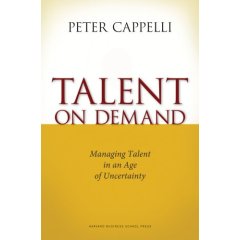Peter Cappelli is releasing his new book “Talent on Demand” in a couple of weeks on the state of the talent management industry. He will be presenting a new model for talent that impacts organizations, employees, job seekers, coaches, counselors and anyone involved in the world of talent. We can already see his view in action in many organizations today.
Cappelli’s approach borrows from the principle of the supply chain and the manufacturing just-in-time revolution, but changes the language from an engineering certainty to a market-based approach with intrinsic uncertainty.
This new workplace dynamic revolves around 4 principles:
1. Make and buy talent: Internal talent development is still the preferred method as it is the cheapest and least disruptive for an organization. Yet, since the cost of unused inventory is a burden too heavy to carry, companies need to undershoot what their talent predictions are. Why undershoot? Because we have to accept the imprecise nature of talent forecasting.
2. Reduce uncertainty in Talent Demand: We have to accept the imprecise nature of talent prediction at its essence. Instead of going after the highly specialized developmental programs, we’re looking at providing training, tools, and framework that can apply to large employee populations and not small sections of your organization. We like this one, as it is exactly what Harver is providing—tools like our gamified behavioral assessment for how to measure soft skills that help all individuals grow!
3. Earn your ROI when you develop employees: Employees will have to share the cost of training, by either investing more of their personal time for training, or paying off the training investment if they leave. Note that new employers hiring employees could pick up the tab, making the reluctance or current training investment disappear. We like this one very much, as it is for the good of all parties!
4. Balance Employer/Employee interest: When it comes to internal mobility, the internal job market within organizations places career management in the hands of employees. That’s one very efficient way to make a market-like approach to career evolution. Plus, it enables others to access a new realm of possibilities without being stopped by a rigid deterministic system. The only element that could stop us: our ability to produce results!
Upskilling your organization’s TM strategy?
Learn more about Harver’s suite of automated solutions specifically for developing and mobilizing your workforce. For a personal walkthrough, schedule a chat so you can see our TM tools in action and get answers to help you remove uncertainty about your next steps for managing talent.


